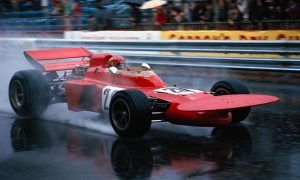
INSIDE THE INTERNAL COMBUSTION ENGINE
In the upper part of the engine, here pictured without the plenum, one can spot the two intake manifolds (which are covered with tape to keep these protected from dust). The cylinder head is cooled down with a specific hydraulic fluid traveling through the red-sealed carbon tube. Below is the ignition coil rail, which comprises a trio of coils (one per cylinder).
On the left-hand side of the picture, at the back of the power unit, one can spot one of the two wastegate pipes that have been added to complement the main tailpipe (see white dotted line) and comply with the new-for-2016 exhaust regulations. Interestingly, the Red Bull RB12 has two additional wastegate pipes when the works Renault R.S.16 machine only has one. Also visible is the turbine inlet, juxtaposed with the compressor outlet, as detailed in page 1.
PRESSURE CHARGING
Having the compressor at the back of the power unit calls for longer boost pipework, as highlighted by the big carbon duct routing the air from the compressor to the intercooler. This theoretically means that more power is required to send the compressed air towards the intercooler. Speaking of which, Red Bull actually uses a split-intercooler setup, with one element placed in each sidepod.
The intercooler inlet and outlet are quite close, as one can surmise from the third picture above. Going back to the RB12 sidepods, each actually houses two radiators: one intercooler and another heat exchanger (on the right-hand side, it serves to cool down the cylinder head). By comparison, Mercedes has a single intercooler lodged within the monocoque itself and ahead of the V6, while Ferrari uses a two-pronged cooling installation with one radiator at the front of the engine and the second at the back.
On the RB12, the cooled air exits the intercooler and is then channelled towards the plenum using the intake manifolds (the grey caps are naturally removed when the engine is used), as shown on the bottom picture.
It is worth mentioning again that the competitiveness of a power unit does not solely derive from its architecture. As good as a design looks on paper, perfect implementation and execution are still required to ensure success. Mercedes and Honda both use a split-turbo solution and it’s fair say that the latter has yet to match the former in terms of performance. Conversely, the Mercedes and Ferrari power units have different architectures, yet they deliver around the same outright power (in race trim at least).






